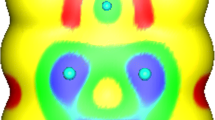Abstract
This paper briefly discusses electronegativity and uses of the electronegativity scale. It demonstrates that values of electronegativity can be used quantitatively in simple equations. Formulas containing derived values of elemental electronegativities are shown to calculate dipole moments, bond lengths, and bond energies reliably. Comparison between calculated and experimental values shows very good agreement in the vast majority of cases.
Graphical abstract

Similar content being viewed by others
Data availability
No confidential data were used in this work. All data are available in the CRC Handbook of Chemistry and Physics or listed in the references.
References
Pauling L (1939) Nature of the Chemical Bond, 1st edn. Cornell University Press, New York
Henderson W (2000) Main Group Chemistry. Royal Society Chemistry, London
Lang PF, Smith BC (2015) Phys Chem Chem Phys 17:3355
Jones CJ (2001) d- and f-Block chemistry. Royal Society Chemistry, London
Shriver DF, Atkins PW, Langford CH (1990) Inorganic Chemistry. Oxford University Press, Oxford
Cotton FC, Wilkinson G (1972) Advanced Inorganic Chemistry, 3rd edn. Interscience, New York
Rumble J (ed) (2023–2024) CRC Handbook of Chemistry and Physics, 104th edn. CRC Press, Boca Raton
Donnay JD, Ondik HM (eds) (1973) Crystal Data Determinative Tables, 3rd edn, vols 1 and 2. United States Department of Commerce, National Bureau of Standards and Joint Committee on Powder Diffraction Standards, Washington DC
Ondik HM, Mighell AD (eds) (1978) Crystal Data Determinative Tables, 3rd edn, vols 3 and 4. United States Department of Commerce, National Bureau of Standards and Joint Committee on Powder Diffraction Standards, Washington DC
Mingos DMP (1995) Essentials of Inorganic Chemistry 1. Oxford University Press, Oxford
Norman NC (1994) Periodicity and the p Block elements. Oxford University Press, Oxford
Lang PF, Smith BC (2014) Dalton Trans 43:8016
Lang PF, Smith BC (2003) J Chem Educ 80:938
Lang PF, Smith BC (2010) J Chem Educ 87:875
Schomaker V, Stevenson DP (1941) J Am Chem Soc 63:37
Ives DJG (1971) Chemical Thermodynamics. Macdonald, London
Lang PF (2023). Found Chem. https://doi.org/10.1007/s10698-023-09486-7
Lang PF, Smith BC (2010) Dalton Trans 39:7786
Herzberg G (1950) Molecular Spectra and Molecular Structure I, Spectra of Diatomic Molecules. Van Nostrand Reinhold, New York, USA
Huber KP, Herzberg G (1979) Molecular Spectra and Molecular Structure IV, Constants of Diatomic Molecules. Van Nostrand Reinhold, New York, USA
Harmony MD, Laurie VW, Kuczkowski RL, Schwendeman RH, Ramsay DA, Lovas FJ, Lafferty WJ, Maki AG (1979) J Phys Chem Ref Data 8:619
Donohue J (1974) The Structures of the Elements. Wiley, New York, USA
Jones M Jr (1997) Organic Chemistry. WW Norton, New York
Author information
Authors and Affiliations
Corresponding author
Additional information
Publisher's Note
Springer Nature remains neutral with regard to jurisdictional claims in published maps and institutional affiliations.
Rights and permissions
Springer Nature or its licensor (e.g. a society or other partner) holds exclusive rights to this article under a publishing agreement with the author(s) or other rightsholder(s); author self-archiving of the accepted manuscript version of this article is solely governed by the terms of such publishing agreement and applicable law.
About this article
Cite this article
Lang, P.F. Quantitative applications of the electronegativity scale. Monatsh Chem 155, 507–513 (2024). https://doi.org/10.1007/s00706-024-03191-7
Received:
Accepted:
Published:
Issue Date:
DOI: https://doi.org/10.1007/s00706-024-03191-7




